It’s no secret that I love planning anything and everything! One of my favorite types of planning is travel planning 🙂
Some people like to just ‘go with the flow’ and find stuff when they get to their destination. Definitely not me! I like to plan everything in detail, so I know exactly what I’m doing each day. That way no time is wasted, you don’t miss out on things because you didn’t realise they were closed, you don’t get lost etc.
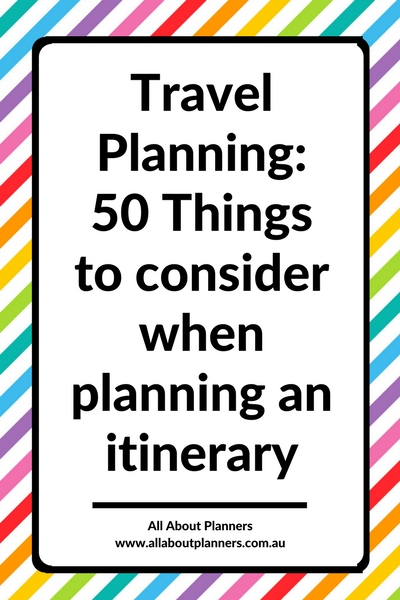
Here are 50 things I consider when planning an itinerary:
In no particular order…
Preliminary Planning
1. Time of year & weather
In winter, snow and ice can cause delays (for everything) – especially flights. It’s not an ideal season to be driving, especially if you aren’t familiar with very cold weather. It’ll also limit what you can and can’t do – some things close down during winter and you won’t be able to stay outside in the freezing cold for long anyway.
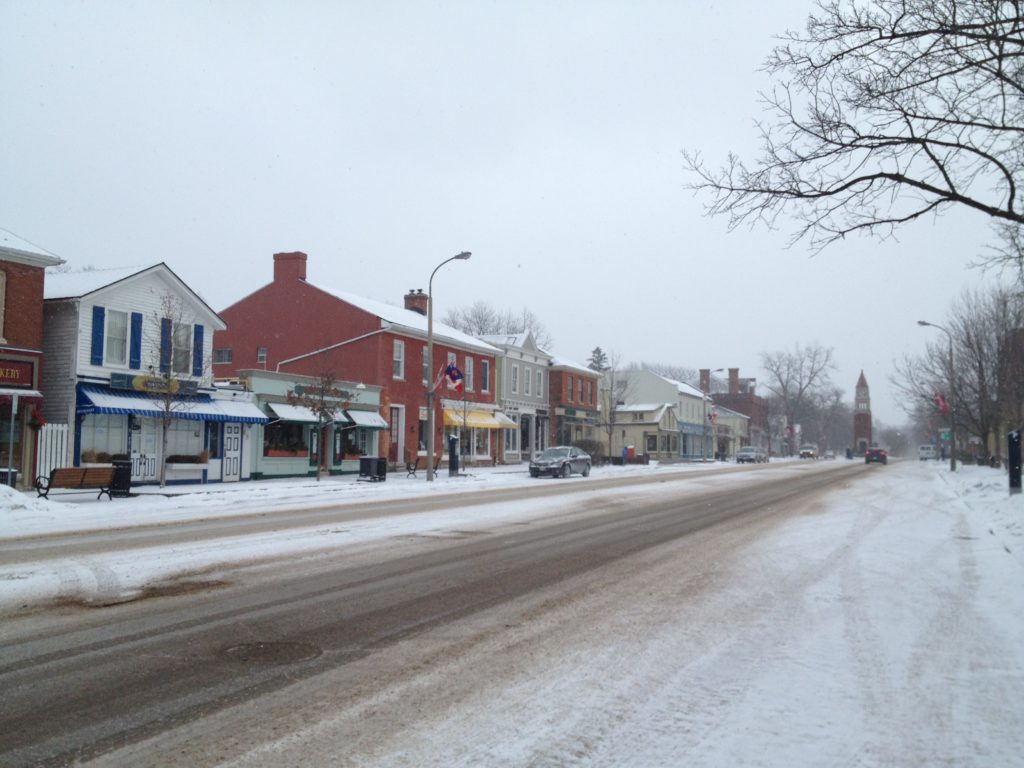
Niagara on the Lake in winter… pretty but very cold and a lot of things are closed during winter
In summer, you’re more likely to get suburnt and dehydrated so it’s not a good time of year for bushwalks and intense physical activity. In Australia, hot temperatures can cause total fire bans meaning national parks are closed.
Depending on where you’re going, summer or winter may be peak tourist season meaning everything will cost more and be more crowded so your trip may not be as enjoyable.
For those reasons, I prefer to travel during Spring (when flowers are in bloom) and Autumn (when the leaves turn orange & red) – the weather tends to be just right for adventuring during these 2 seasons!
Within the season, when planning the actual itinerary, I like to include days that can be swapped around (which is why city passes are so handy) so if, for example, you were visiting New York and the Highline was shut due to snow you could swap that day around and do something different.
Another factor that definitely needs to be considered is holiday periods, especially national / public holidays. If you work a day job like I do and have limited annual leave so are forced to travel during national holiday periods, make sure you take the following into account.
During public holiday periods:
- Takes longer to get through queues
- Public holiday surcharges when eating out (at least that’s the case here in Australia)
- Pay a premium for accommodation
- Pay a premium for flights
- Public transport more busy
- Public transport may be less frequent due to track / maintenance work
- Depending on the type of holiday (e.g. religious), some attractions and stores may be closed or have reduced operating hours.
2. Organized tour versus go your own way
If you want to do an organized group tour you’ll have to be flexible and choose the travel dates they offer, which may be during peak tourist season when places are packed with crowds.
If you’re travelling with more than 1 or 2 other people then going your own way and hiring a car is probably going to be cheaper than a group tour.
Pros of booking a group tour
- Good for hard to access locations
- Learn more about the history of the destination etc. if that is stuff that interests you
- Less stressful – you don’t have to worry about getting lost
- Most of it is pre-paid so you don’t have to carry a lot of cash on you
- You tend to get priority access / faster entry into attractions as most tour groups have pre-arranged things with vendors
- You’ll be with other people that can take a photo of you (or of you and your travel companion so you don’t have to take a selfie)
- If you’re not comfortable driving (especially in a foreign country) it means you can still go and not have to miss out altogether on seeing things
- Good for solo travel – easier to meet people
Cons of booking a group tour
- Have to stick with the tour – you may have to do activities that don’t interest you, spend more time at attractionss you don’t really want to see and less at attractions you do want to see
- The accommodation is always farther out from the main ‘hub’ / tourist attractions so tour companies can keep the cost of the tour down
- Your photos probably won’t turn out as good. When you travel with a tour group you have to adhere to specific timeframes. If the tour group is a hoard of 30 or so people you won’t have the luxury of waiting for people to clear out so you can take a good photo
- If you’re an introvert like I am, spending a number of days with a bunch of people (especially some which you wouldn’t normally associate with) can get annoying and really test your patience
- There is always someone or a group of people who are consistently late back to the tour bus – rude!
- If you’re travelling solo you’ll have to pay more to get your own room if you don’t want to share with others
- Organized tours are usually fast paced – a ‘taste test’ of places – if you prefer to travel slow it may not be a good fit for you
- Some tour companies have age restrictions
Download the checklist!
3. Which day of the week are you leaving?
I plan my holidays around public holidays. Yes it costs more to travel at these times of year but to me it’s worth it if I can get extra days off without using more leave. Given that I work a day job I need to be strategic about how I spend my leave days. If there’s a public holiday on a Monday then I take the Tuesday off the day off to travel back. Travelling in the couple of days before or after rather than the public holiday itself is always cheaper. If you are travelling during this peak period you’ll need to book far in advance so you don’t miss out.
In Australia, flights tend to be cheaper mid-week as not many people want to travel on these days, with a premium for Friday and Saturday flights.
Another thing to consider if the time of day. If you’re arriving at your destination during peak hour, you’ll pay a lot more for a cab while you sit in traffic. Public transport can also be harder / more time consuming to navigate if it’s packed with crowds.
4. Who are you travelling with?
Another factor to consider is if you’re travelling alone, or with a sibling, a parent, group of friends etc. Everyone has different interests, different fitness levels, food tastes etc. When I travel with my parents I have to be careful not to pack too much into the itinerary and not do too many physical things.
I find museums rather boring so if I’m travelling with someone that likes going to them, we’ll usually split up that day, go our separate ways and each go see what we want to see then meet up again for dinner. Doing this also means you get a break from the other person – which can become necessary for both you and your travel companion’s sanity if you’re travelling with them for a long period of time!
5. Travel Warnings / Safety
I’d love to see the pyramids but I don’t think it’s very safe at the moment. While I know you have to be quite unlucky to fall victim to something like a terrorist attack I’d rather minimise the risk as much as possible. Besides, there are plenty of places higher up in my travel bucket list!
Money
Related: My printable travel planner
6. Budget
Budget will obviously play a big role in what destinations you can go to and how many things you can see.
Don’t forget to factor in:
- During holiday periods everything will cost more
- Exchange rates (and currency conversion fees)
- Airport transfers (including to and from the airport in your departing destination)
- Contingency
- City taxes
- Tipping
- Taxi’s can cost more or less than online fare calculators – take them as a guide only and always add a few dollars more (I tend to round up to the nearest 5)
- Unexpected souvenirs or things you find along the way
- Cost of special clothes or gear you’ll need for your trip such as gloves, winter coats, thermals etc.
- National park entry fees
- Paid parking
- Public transport (off peak versus peak times – fares can vary)
- Discount city passes and transport cards
7. Consult deal websites
There are discounts available for everything when it comes to travel! Booking flights, accommodation and attractions in the one go through a discount website or a travel agent can save money. Just keep in mind that the hotel may not be in an ideal location, or the flights may not be on the day of the week you want. There’s usually conditions about what days of the week the accommodation can be used.
If booking through a travel agent, don’t be afraid to ask for a discount, especially if it’s for a big trip! I always request an itemised breakdown of everything so I can do my own price checks. For some things like the Eurostar train and day tours, they tend to just put the same price as if you booked it yourself. I also find travel agents tend to add a lot of commission on top of insurance and airport transfers – no thank you! I really only use a travel agent for flights and accommodation and only if they can do a better price than if I booked it online.
8. Currency Exchange Rate
Visiting a country where you get a good exchange rate for your money means you can go for longer or stay in better quality accommodation.
I tend to watch a currency 6 months ahead of a trip and transfer bundles of money progressively. Exchange rates can fluctuate quite a bit – even a couple of cents can add up to a lot if you’re transferring large amounts of money.
I use my banks travel card (which has no transfer fee) and the Multi-Currency Cash Passport (I’m not affiliated, just sharing what I use).
9. Day of the week you fly
Every travel agent I’ve spoken to doesn’t seem to think this is a ‘thing’ internationally but here in Australia flights cost more on Fridays and weekends than mid-week.
10. City passes
Popular tourist cities such as New York, London and Paris tend to have ‘city passes’ or discount cards where you can choose a number of attractions from a list, or choose a number of days you want the pass to cover. Always check if there’s a city pass before you go purchasing individual attractions tickets as it could save you a lot of money! Most of the attractions include skip the line options too which can reduce the amount of time you waste queuing.
Note that if you’re only in your destination for a short stay, it may be cheaper to buy individual attractions tickets than a pass. I always do a table with a quick comparison of the cost of purchasing attraction tickets individually versus what the cost per attraction for the passes cards work out to be. Some attractions are cheaper than others and you may only want to visit certain ones.
11. Buy your flights at the same time
If you visit a travel agent they’ll always tell you to book all of the flights at the same time as it’s cheaper to put it all on the one transaction. I find it’s always cheaper to buy a return ticket than 2 one way tickets, even if you’re arriving and departing from different airports.
12. Check the airline’s direct website
Sites such as Webject and Skyscanner are handy for comparing the cost of flights, but they usually charge a small commission. If you go to the airlines website and do a direct search it tends to come up about $10 or so cheaper (at least this has been the case whenever I look up flights).
Too many things to remember? Download and print the checklist!
The Destination
13. How long are you going for?
If you’ve only got a short amount of time it’s better to visit less places (travelling slower also makes it cheaper). Some places are ok for a short stay but I don’t tend to visit somewhere for only 1 or 2 days. I tend to go for a minimum of 4 days so I can adequately see everything. You never know if you’ll ever be able to return to that place and it’s expensive and time consuming to get to places (especially if you’re in Australia like I am!) so I’d rather see more of the one place than just a drive by where you don’t really see the place.
The other thing to consider is how much you can fit in your suitcase. If you go for long the cost per day will be cheaper but you may end up having to purchase an extra suitcase, pay for things to be shipped back home (it can sometimes be cheaper just to buy another suitcase and pay excess baggage airline fees) as well as carry more clothes if you’re travelling during a change of seasons.
14. Lighting for photos
Some places look better in morning light, or you may want to visit a place to take a shot at sunset. I usually do a google search of the destination or search for blogs with photography tips e.g. a search for ‘best time of day to photograph the Eiffel tower’
I prefer to take photos mid-morning or mid-afternoon. Whenever I’ve taken photos in the morning, it creates an annoying glare on photos. It also seems to add a reflection when I take photos from inside a car.
15. Public transport schedule
During holidays some (or all) public transport services can be cancelled or changed to a less frequent timetable so be sure to factor this in to your travel times or change your itinerary so these days are mostly walking around a city rather than a day trip.
16. Public holiday opening hours & surcharge
Some tourist attractions are closed on public holidays or have shorter opening hours. Most don’t release their opening hours until closer to the holiday season’s dates so if you’re planning far in advance, I’d avoid risking it and tweak your itinerary (if you can) so that you aren’t planning to visit on the public holiday.
Some food places also add a surcharge (at least they do in Australia) if you eat out on a public holiday.
17. Events happening in the city
Events could include not only looking at national holidays but also local events like markets, festivals and concerts. Even if they’re not something you want to attend they can increase the price of accommodation, cause transport delays, restaurants can be booked out, increased queuing time etc.
For example, cycling doesn’t interest me in the slightest so when I visited Ballarat, I didn’t know there would be a big cycling event that would close roads and ruin all my photos of the main street 🙁 Lesson learned: check the destinations website for upcoming events that could ruin your holiday plans!
18. School holidays of the destination you’re travelling to
Even though you may not be in school anymore, make sure you check when school holidays are, especially if you want to visit a theme park or a zoo. In Australia (where I live) each state doesn’t have the same holiday period so be sure to Google school holidays for each destination you’re going to.
19. Day of the week
If there’s something you really want to see and you don’t want to battle long queues, or have tons of tourists photobomb, or nearly knock you out with their selfie sticks, then you gotta plan your trip to avoid visiting the main tourist attractions on a weekend.
Mid-week (Tuesday & Wednesday) are ideal days when there tends to be fewer crowds.
20. Shops
If you’re going somewhere remote where you won’t have access to shops, you better double and trip check that you’ve packed everything! If you’re on a budget consider choosing accommodation which has a kitchenette and is in close proximity to a supermarket so you can cook your own food rather than eating take out.
Related: My printable travel planner
Transport
21. Do you have access to a car?
A hire car is definitely preferable for exploring and almost always a must if you’re not visiting a city in order to see everything. However, it’s important to weigh up whether the cost of hiring a car and paying for fuel, insurance etc. is worth it. Especially if you’re under 25 – most companies charge higher insurance premiums. Sometimes it’s cheaper to just do an organized day tour.
22. Type of roads
If you do have access to a car, be sure to check the type of roads on the route you want to go. You can ‘drive’ the route on Google maps – a quick check of the type of road before you leave for your trip can save you a lot of time and hassle. E.g. you can see which roads are unsealed / gravel and should be avoided if you’re hiring a sedan not a four wheel drive. Moreover, if there’s multiple route options, one might be quicker but it might be a windy single road through thick trees where there’s no option to turn around once you’re on that road. So if you’re inexperienced or not a confident driver, definitely check before you go!
23. Petrol station locations
If you’re driving your own car or hiring one, you’re going to need to top up with fuel at some point. I put a reminder on the itinerary each day that I have the hire car to remind me to check the fuel level. I tend to plan petrol station stops on long stretches to break up the trip, get a chance to clean the windscreen for photos, walk around, or stop near a lunch spot.
24. Snacks
If you’re road-tripping around Australia or any other country with warm temperatures, most snacks will melt if you leave them sitting in a car. My go to travel snacks are:
- Meusli bars
- Popcorn
- Biscuits (especially those with rolled oats in them such as Anzac biscuits as they really fill you up!)
- Nuts (make sure you check immigration laws, some countries don’t allow you to bring nuts)
- Lollies
25. Road rules
If you’re deciding whether to hire a car or choosing a pickup location for car hire (e.g. CBD versus airport) make sure you consider road rules such as different sides of drivers wheel, road rules when driving alongside trams (such a right hook turns in Melbourne) etc.
Map out the route from the car hire pickup to where you want to go also taking into account one way lanes and roads with multiple lanes where it may be difficult to do a left or right turn and get across multiple lanes of traffic as well as avoiding toll roads. While you can rely on Google Maps I like to have a rough idea in my head before I go just in case I get lost or something happens with my phone as most car hire places will charge extra for a GPS.
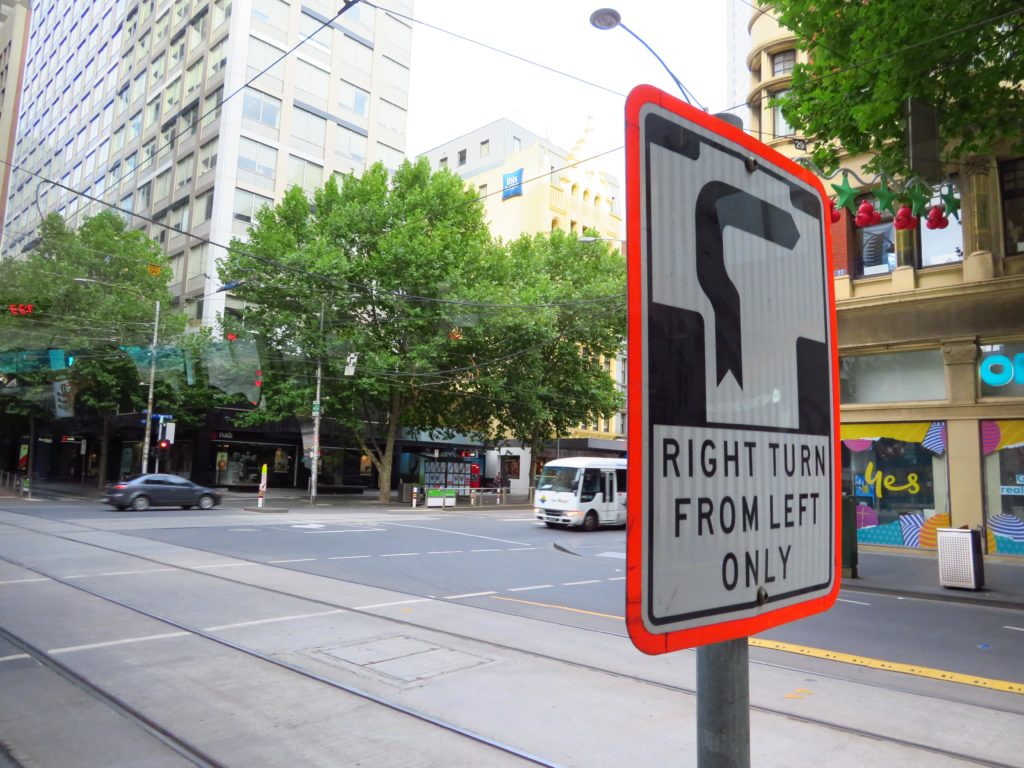
Melbourne CBD Hook Turns
26. Public transport
Some places are easily accessible via public transport rather than taking an organized tour. However, if you’re a first time traveller you may prefer to pay for a shuttle bus airport transfer rather than figure it out yourself.
I always ask the hotel concierge for directions. They’re usually bored and are grateful for something to do and give you other tips such as good places to eat and the best time to visit attractions to avoid queues!
If it’s your first time visiting a big city you may be a bit nervous about the public transport situation especially if multiple buses and / or trains are required. However, it’s usually not as complicated as you’d think. There’s almost always a ticket counter and if not, there’s always Google!
27. Driving Distances
How long can you drive? I’m someone that finds driving incredibly boring and tend to get sleepy after only half an hour driving, especially if it’s a straight stretch of road. Hence why I prefer to travel with someone else that can drive, so I can take photos or fall asleep in the passenger seat if need be.
You also need to consider your destination. Driving 6 hours on the east coast of Australia is very different to driving 6 hours on the west coast of Australia. Make sure you consider the terrain (e.g. winding mountainous roads, icy roads versus the straight roads that stretch on for hours in the outback) and factor in stopping / rest times.
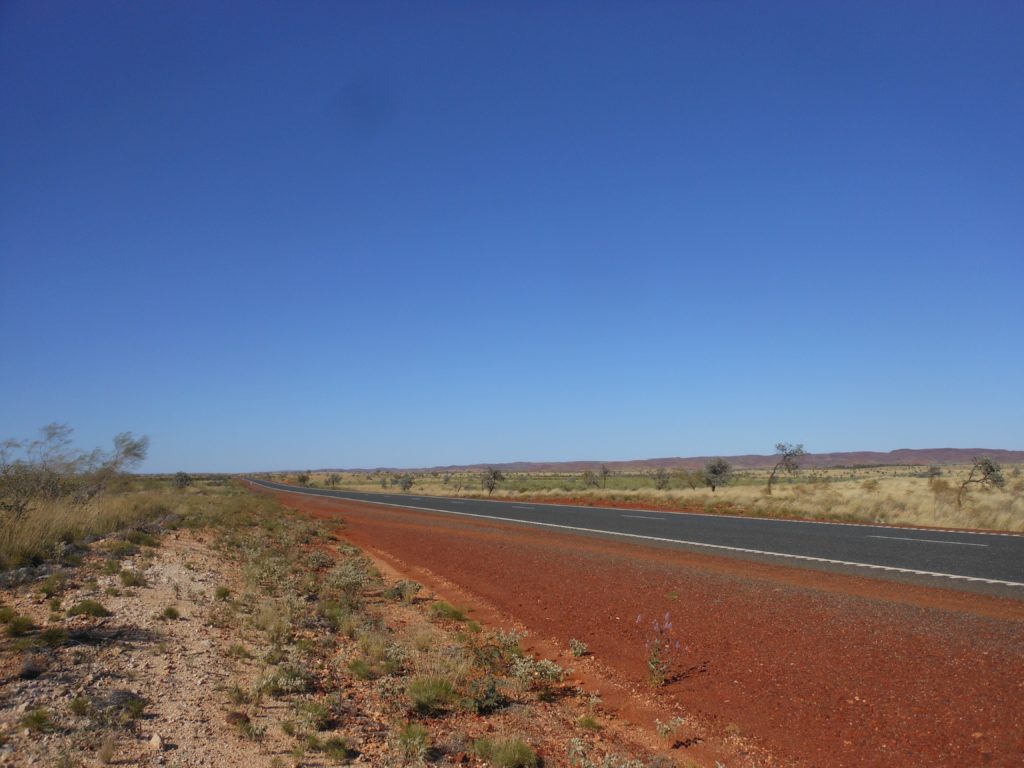
Allow extra time for rest stops if you’re venturing into the Aussie outback!
(Photo taken in the Pilbara, Western Australia)
28. Time of day on the road
Traffic jams can guzzle a lot of your holiday time. You might hit the road early but then spend that extra time you ‘gained’ sitting in traffic when you could’ve slept in.
Flying
29. Flight Times
I prefer to arrive in a new country in the afternoon (local time). This way you still have time (after clearing customs) to wander around the area around your hotel and get some dinner before heading to bed. This arrival time is ideal if you get super excited by travelling (like me!) and know you won’t be able to go to sleep straight after a long haul flight /s.
30. Stopover Destinations
If you want to break up a long haul trip like travelling to / from Australia to, well, practically anywhere else in the world and you have the luxury of time, consider a stopover in Hawaii, Asia or the UAE. A couple of days can make the long trip home back to reality slightly less depressing and you can choose a connecting flight at a time where the fare is cheap.
31. Choose a safe airline
I don’t care if an airline that has a crap safety record is cheaper. I’m not going to save a couple of hundred dollars and risk my life flying with those airlines. I’ll choose comfort and safety over a budget airline any day. Especially for long haul flights.
32. Airport transfers
Sometimes it’s cheaper to just take public transport to your hotel. However, if you want to avoid hassle and are prepared to pay a premium, then a taxi would be the way to go. They’re really only economical if you’re travelling in a group though. Uber and shuttle buses are another option. If you’re going to use a shuttle bus, make sure to check online as sometimes the price will be cheaper. Also, some (such as the Melbourne Skybus) have a slight discount if you book a return ticket rather than buy 2 individual tickets (saves the hassle of queuing twice as well).
Don’t miss including the cost of airport transfers in your budget as they can add up to quite a bit. Most major airports have shuttle services. While they tend to be cheaper it will take much longer as you have to drop everyone else off at their hotels before you get to yours.
If you’re going somewhere remote you’ll want to pre-arrange airport transfers but if you’re going to a major airport like LAX or Heathrow, just arrange it when you arrive. Unless you’d rather be stress free. It’s really up to personal preference!
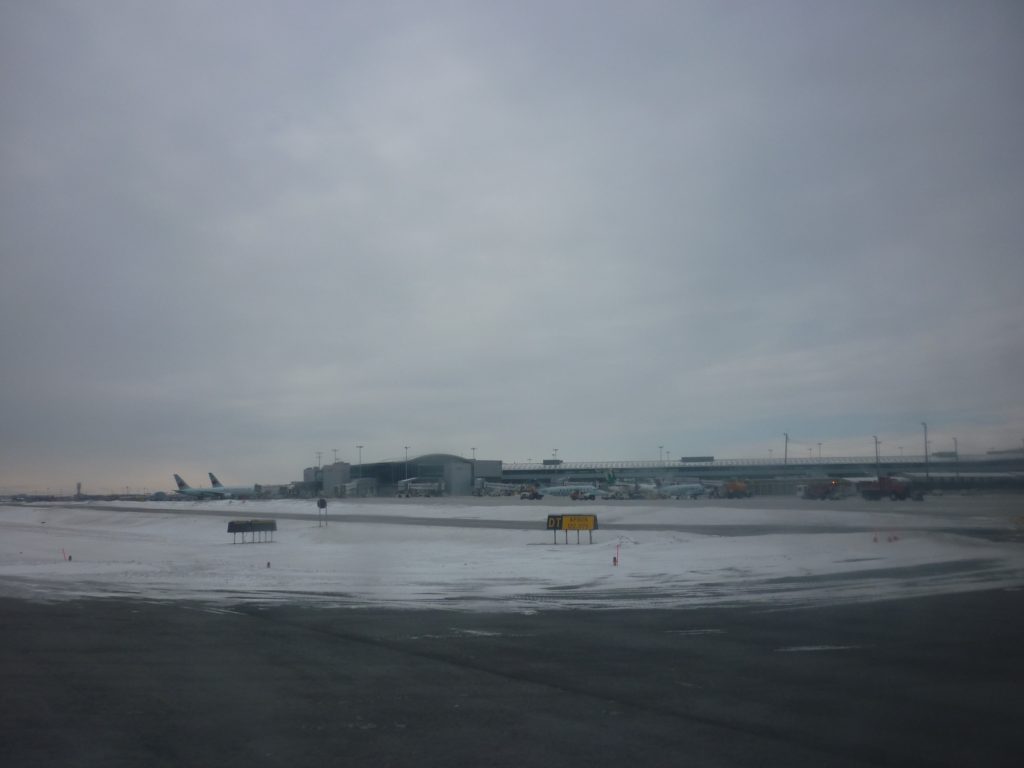
Update your travel insurance and plan for unexpected delays or flight cancellations in winter
(Above photo taken at Toronto Pearson International Airport)
Accommodation
33. Central hotel location
I always choose a hotel in a central location. Yes it’s more expensive but it pays for itself many times over when:
- Save time travelling to the main attractions so you have more time to see more things
- Generally have better transport links – more regular trains, buses etc. and shuttle buses to and from the airport
- Generally higher quality hotel with a concierge you can ask questions
- Safer, especially at night and if you’re a first time solo traveller
- Most day trip transport pickup is from central hotels
- Close to food places for dinner
- Close to shops and chemists if you forget e.g. your toothbrush
34. Do you have access to a washing machine?
I have no qualms about wearing a shirt twice without washing if I’m short on suitcase space but if I’m going on a long trip I’m going to need to wash clothes at some point! Motels almost always have laundry facilities (and much cheaper than hotels). If you’re going somewhere remote you can always wash a couple of items each night and hang on the side of a tub to dry. Rolling them on a towel also helps them dry faster.
I always schedule in the days I’ll be washing (and what I’ll be washing) into the itinerary. Make sure you consider what you’ll be doing the next day i.e. I tend to avoid doing it on the last night at a location as the departure day usually involves an early wakeup and less time for the clothes to dry.
35. Free Wifi
Free wifi is a must for me so I can run my Etsy shop and post on the blog! More expensive business style hotels tend to charge for wifi, while 3 – 4 star hotels (especially motel style) almost always offer wifi for free. If I’m already paying for a hotel room I don’t see why I should pay extra for wifi too! If I’ve booked a hotel with paid wifi I casually ask when checking in ‘what’s the go with wifi?’ or ‘can I please get the wifi password’. I’ve had a few occasions where you can sign up for their membership (free) and they’ll give you the wifi password for free 🙂
36. Sleeping arrangements
Hotel comparison sites such as Booking.com and Trivago are my favorite. These websites:
- Have good photos of hotel rooms
- Reviews from travellers that have actually been there (and give the hotel a rating out of 10 as well as recommendations of what type of person e.g. couple is best suited to staying there)
- Plots hotels on a map so you can get a visual of how close it is to things and gives you a visual of the available sleeping arrangements
- List out the facilities at the hotel such as whether it has a gym
- States whether wifi is included or if you have to pay for it
- Highlight what the cost is if you want the option to cancel versus no cancellation
I don’t mind sleeping in a single bed. In fact, I prefer it. My sister is the complete opposite – a double bed is a must for her! Most hotel booking websites give you a visual of single or double beds – make sure you double check. I’ve booked ‘twin share’ before and the room ended up being 1 single and 1 double beds. Other times it was 2 double beds.
Attractions
37. Prioritise
What do you really want to see that you would be kicking yourself if you missed out on it? If, after you returned from your trip you fell ill and never got a chance to travel again (a bit of a dramatic hypothetical situation I know) – but what would you be most disappointed you never got to see? Those are the places you should visit. If there are so many things to choose from and you don’t have enough time to see them all you may need to change how many days you have scheduled at that destination.
38. Proximity to food
If there’s a specific place you want to go to for lunch or to get gelato etc., plan what time you want to eat and schedule visiting attractions that are close by so you’re not wasting time travelling here, there and everywhere.
39. The cost of attractions
Most major tourist cities offer city passes – a pass that’ll give you a reduced cost per attraction entry fee. These discount cards allow you to choose a number of attractions from a list, or choose a number of days you want the pass to cover. Always check if there’s a city pass before you go purchasing individual attractions tickets as it could save you a lot of money! Most of the attractions include skip the line options too which can reduce the amount of time you waste queuing.
Note that if you’re only in your destination for a short stay, it may be cheaper to buy individual attractions tickets than a pass. I always do a table with a quick comparison of the cost of purchasing attraction tickets individually versus what the cost per attraction for the passes cards work out to be. Some attractions are cheaper than others and you may only want to visit certain ones.
If you’re travelling as a family there’s almost always a saving in purchasing a family ticket than individual tickets to make sure you check this too!
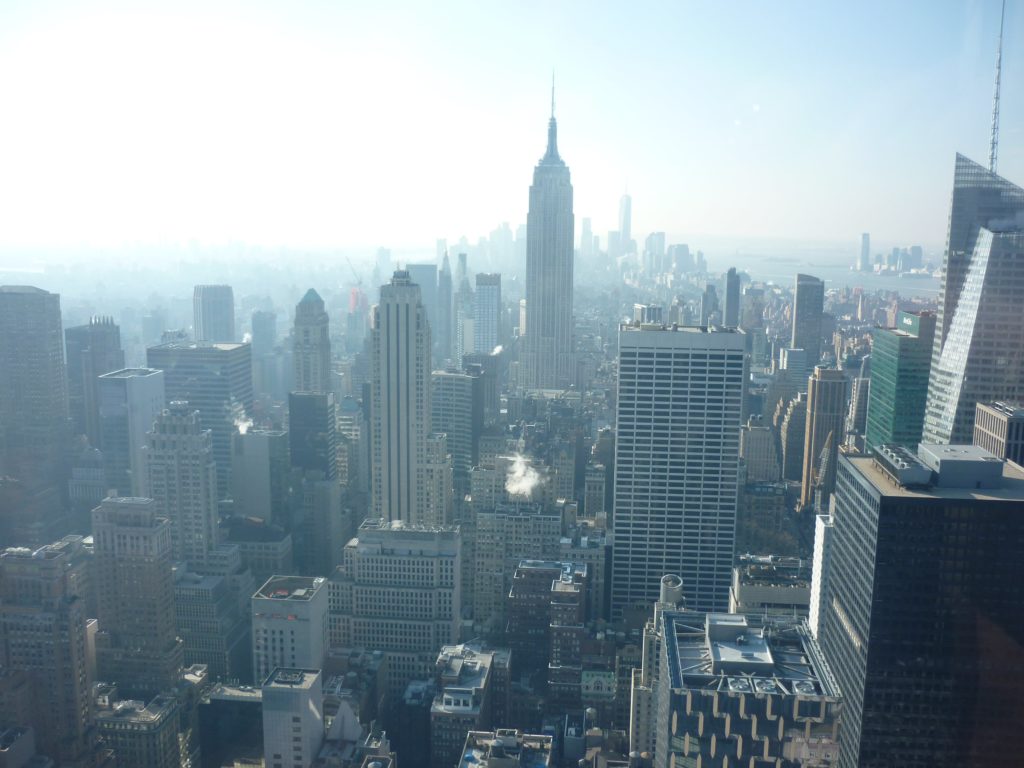
Top of the Rock in New York – a paid attraction but the view is worth it – even on a cold winter’s day!
40. What’s happening around the other days?
I can spend months planning an itinerary – carefully scheduling things and considering all of the various factors on the list. One of the big things I consider is what’s happening on other days. I avoid scheduling day tours on the last day in a city as they usually get back to the hotel quite late. Since I’m likely to have to get up early the next day to catch a flight this isn’t ideal. Another thing to consider is spacing out days where there’s a lot of walking involved.
I also consider nights I need to wash my hair and clothes too.
41. Opening hours of attractions
Some attractions open at 9am but others don’t open until 10am. Some aren’t open on certain days or have shorter opening hours on certain days as well.
Depending on the attraction there may be special events or shows that occur only once a week or on certain days – if there’s something you really want to see, make sure you plan accordingly. I like to color code ‘non-negotiable’ things in a different color on the itinerary to ‘if I have time’ attractions.
Related: Color coding your planner: how to choose which colors to use
42. What other attractions are nearby?
I like to plan in clusters. My favorite trip planning tool: Visit a City makes this very easy with pre-generated itineraries that you can customise to suit the attractions that interest you.
Related: My all time favorite trip planning tool: Visit a City
43. Allow extra time
Everything always takes long than you think. Google maps may say that it takes 30 minutes to drive somewhere but if it’s a scenic route and you want to pull over multiple times to take photos the trip is going to take longer than that.
Similarly don’t forget to anticipate extra time for queuing to get into attractions, especially on weekends.
44. Variety
Castles are cool, but if you visit 3 castles in 3 days the novelty is going to wear off. Make sure you include some variety and break things up. Rather than spending 4 days straight in one city I like to include a day trip around day 2 or 3 to mix it up. Similarly, taking a hop on hop off bus, or a boat tour rather than just exploring on foot can give you a new perspective.
Reviews
45. Tripadvisor reviews
Tripadvisors has a plethora of reviews from tour companies to attractions to hotels and food places. While I don’t base my entire decision on whether I stay at a hotel, eat at a restaurant or visit an attraction based on Tripadvisor reviews it can be helpful in weeding out companies that are very unreliable.
If you post your itinerary in the forums people also give feedback and suggestions for places to see and things to do that you may not have otherwise thought of, and advise you if you’re likely trying to cram too much in.
46. Ask people that have been there
One of my favorite sources is asking people with similar tastes and travel style as myself. I asked 5 different people with similar personality / tastes as me what they thought of Stonehenge. All of them said it was over-rated. I wasn’t too keen on visiting it my first time going to London and asking them confirmed for me that it wasn’t a must so I’ve left it off the itinerary (this time).
47. Positive and negative reviews
I always make sure I read a couple of 5 star reviews as well as some negative reviews. I tend to go for 4 or 5 star ratings overall, however on rare occasions a particularly bad 1 star review has turned me off booking that hotel, tour etc. There are reviews for almost anything these days and you can spend a lot of time reading them. To save time, I use CTRL and F on my keyboard to search for keywords such as bed bugs, noisy, dirty etc.
![]()
The 12 Apostles – everyone I asked told me it was worth it and I have to agree – definitely a must see and much more spectacular in person than photos!
Packing
48. Clothing Choice
If you’re travelling in winter you’ll need to cart all that winter gear. ‘Vaccum seal’ type bags can save space. I always use packing cubes (no matter what time of year I’m travelling) to keep everything organized! If you don’t want to buy some, large clear clip top bags will do.
When choosing what clothes to bring also take into account whether any of your accommodation has laundry facilities.
No matter if I’m going somewhere cold or stinkin hot I’ll always pack jeans (or wear them on the plane). Weather can be unpredictable and evenings can be cold. I also always pack a wind breaker as they can be used as a ‘blanket’ and protect from rain and the cold. Plus they roll up really compact.
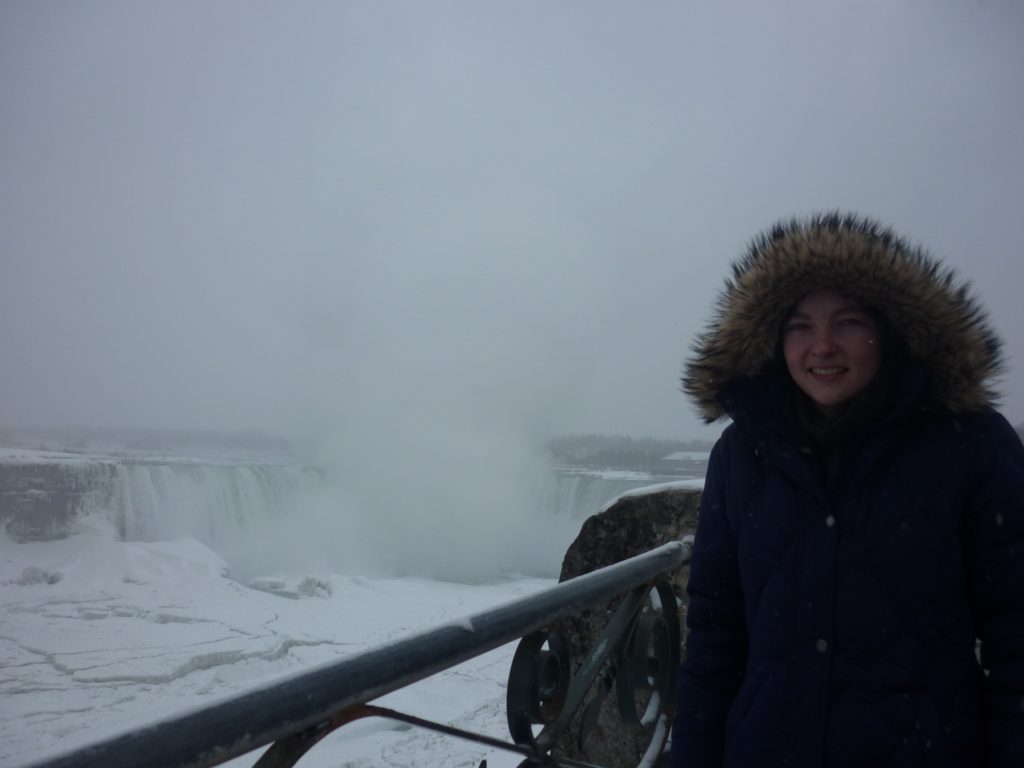
Should’ve packed more thermals! Freezing in -30 degrees at Niagara Falls
49. Choose the right suitcase for the destination
Consider:
- If you need to lift the suitcase yourself (i.e. travelling solo)
- Hard shell in snow / cold climate so stuff doesn’t get soggy if your suitcase is sitting on the tarmac waiting to be loaded onto the plane
- A secure bag when travelling to the USA with a TSA lock. I prefer to buy luggage that has this built in (which most suitcases these days have) rather than fussing about with a separate lock (and paying extra for it)
- 2 wheels versus 4. I’ve been fully converted to 4 wheel suitcases – they’re so easy to push and can be used in 2 wheel style if you prefer (they don’t tend to work that great on carpet)
- Size – if I’m doing a quick trip I’m not going to lug a giant empty suitcase, especially not a hard shell suitcase as these can get dented in luggage if you leave them mostly empty
- Color – I always buy bright colored luggage so I can quickly spot it on the luggage carousel – plus it’s prettier than boring black!
50. Wall adaptor plugs
Make sure you have the right ones for each country and remember to check that the plug arrangement is correct. I.e. make sure the front of the plug fits the plugs used in your country not the other way around!
Backup Plans
51. An ‘If We Have Time’ List
Sometimes things take longer than you expect and sometimes they may not take as long. In the event that something is unexpectedly closed (for example, when I went to Melbourne there was a total fire ban due a heatwave and they closed the national parks 🙁 ), then you’ll want to have a backup list. This is a list of things you don’t mind if you miss out on seeing but if you have time then these would be the things you’d most want to see.
Now what?
So once you’re armed with all of this info, where to next? This is what I generally do:
- In the interary, add the things that are fixed (i.e. attractions only open on certain days)
- Use different colors for things that can’t be swapped around versus things that can
- Put in the things you really want to see first and keep a list of ‘maybe’ attractions and other things you want to see – just in case you have time or your original plans are cancelled
- Add in hair washing and clothes washing nights
- Add in reminders to do things like phoning companies to confirming your bookings on day tours if they require this
- Depending on how far in advance, factor in the weather for each day and plan what you’ll be wearing
Want more trip planning tips? Check out my printable travel planner!
Found this post helpful? Pin it!

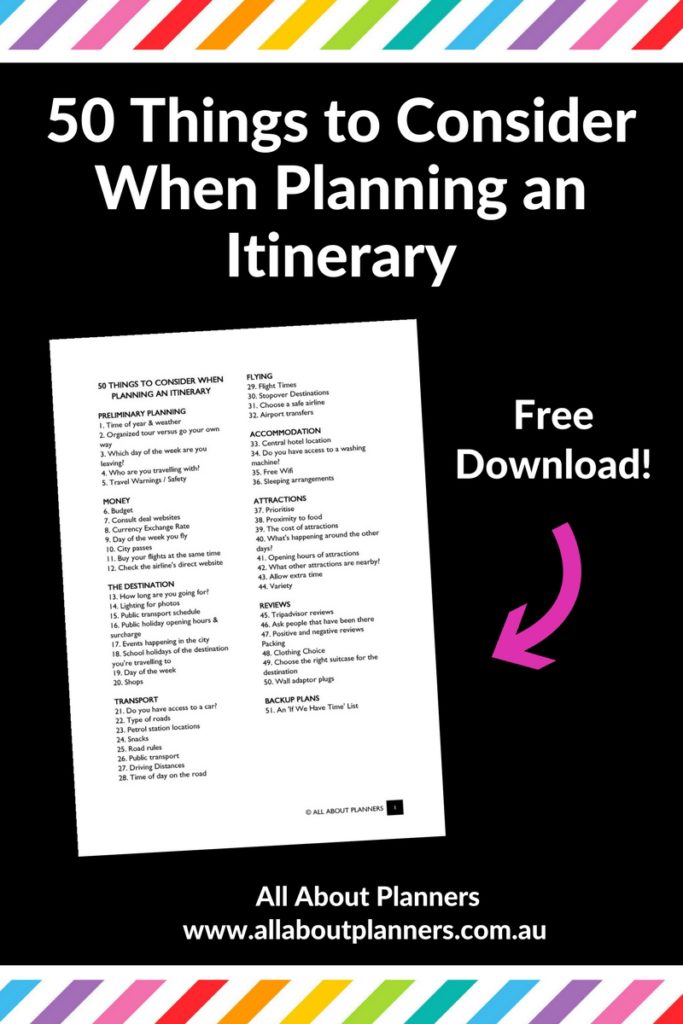
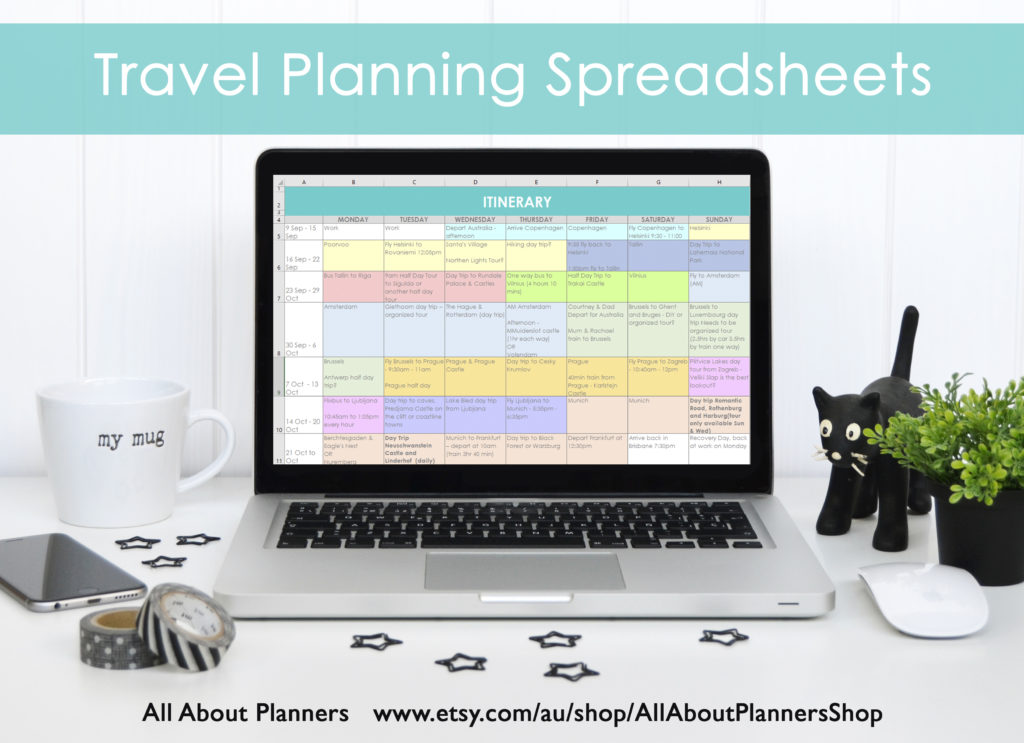

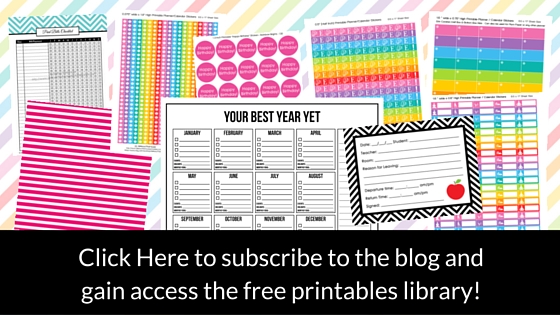
Looks great, we lease a car in Paris, anything longer than 30 days it works out cheaper than hiring a car. Also some countries in Europe have siestas for a couple of hours,everything is closed. We carry a picnic hamper and leave with it with family after we have finished touring Europe and the U.K. But you could just use a drawstring bags, add some plastic plates,and cutlery, cups, and teatowel.We get sick of the rich foods, and long lunches so quite often we just go to the supermarket, buy a breadstick, ham, cheese etc and just have that for lunch whilst enjoying the view somewhere. We also take a thermos, travelling when it is cold in isolated areas we can always have a cuppa.
Stonhenge we have been a couple of times. First time you could walk in and around the stones, now it is all fenced off so for me that was disappointing.